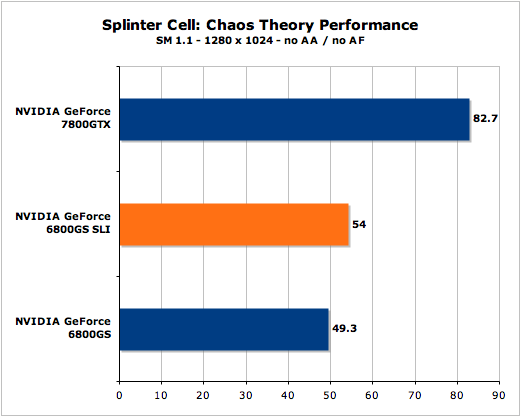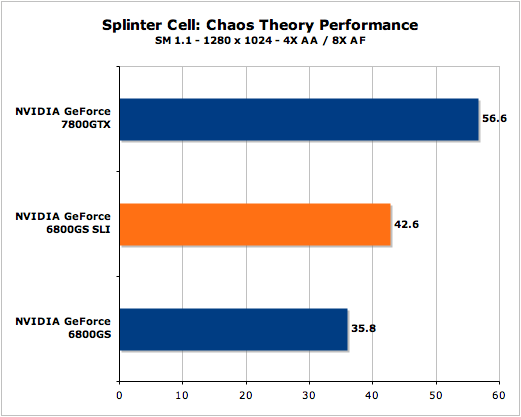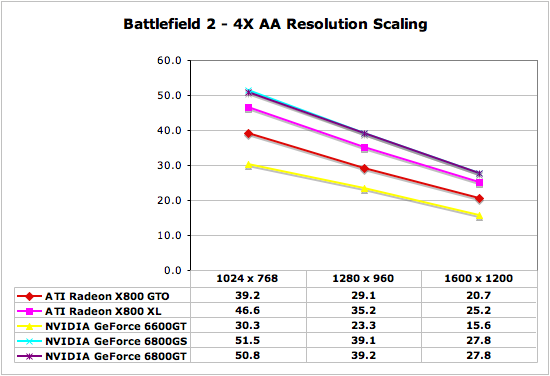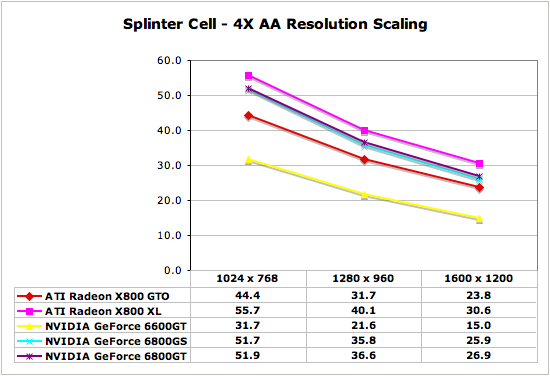The Holiday Stop Gap: GeForce 6800 GS
by Derek Wilson on November 7, 2005 9:00 AM EST- Posted in
- GPUs
SLI and Antialiasing
SLI can end up nearly doubling performance in some cases. In those cases we will see two 6800 GS cards deliver performance on par with a single 7800 GTX. But much more of the time we will see only a modest performance gain from SLI. Since one 7800 GTX costs about the same as two 6800 GS cards, we have to strongly recommend against going with 6800 GS SLI. If performance is desired and the money is there, the 7800 GTX is the better buy by a long shot.
The memory bandwidth of the 6800 GS makes antialiasing possible on most games at 1280x1024 and below. At higher resolutions, AA performance might not be where we would like. Games like Half-Life 2 will certainly run fine on a 6800 GS with AA enabled at 1600x1200. But the SC:CT and BF2 tests we ran show that the 6800 GS just doesn't have what it takes to make 1600x1200 with 4xAA a reality.
SLI can end up nearly doubling performance in some cases. In those cases we will see two 6800 GS cards deliver performance on par with a single 7800 GTX. But much more of the time we will see only a modest performance gain from SLI. Since one 7800 GTX costs about the same as two 6800 GS cards, we have to strongly recommend against going with 6800 GS SLI. If performance is desired and the money is there, the 7800 GTX is the better buy by a long shot.


The memory bandwidth of the 6800 GS makes antialiasing possible on most games at 1280x1024 and below. At higher resolutions, AA performance might not be where we would like. Games like Half-Life 2 will certainly run fine on a 6800 GS with AA enabled at 1600x1200. But the SC:CT and BF2 tests we ran show that the 6800 GS just doesn't have what it takes to make 1600x1200 with 4xAA a reality.












70 Comments
View All Comments
bob661 - Monday, November 7, 2005 - link
Where can you get one of these? I have someone that would be interested.DerekWilson - Monday, November 7, 2005 - link
i linked it on the first page of the article ...http://labs.anandtech.com/search.php?q=6800gs">http://labs.anandtech.com/search.php?q=6800gs
flynnsk - Monday, November 7, 2005 - link
WOW ... another PAPER LAUNCH....According to AT the 6800GS is available today.. yet searching several Etailers and Manufacturer sites show either nothing at all or at most "backordered".
Newegg - Nothing
Zipzoomfly - Natta
Pricewatch - Zip
Amazon - "unable to find exact matches for your search for 6800GS"
PNY- "BACKORDEREDSHIPPING SOON!"
Chaintech - (none) http://www.chaintechusa.com/tw/eng/product_list.as...">http://www.chaintechusa.com/tw/eng/product_list.as...
Albatron -(none) http://www.albatron.com.tw/english/it/vga/pro_list...">http://www.albatron.com.tw/english/it/vga/pro_list...
eVGA.com (none) http://evga.com/products/prodlist.asp?family=GeFor...">http://evga.com/products/prodlist.asp?family=GeFor...
Innovision - http://www.ivmm.com/where/where_america.htm">http://www.ivmm.com/where/where_america.htm (None available)
Leadtek - http://www.leadtek.com/graphic.html">http://www.leadtek.com/graphic.html (none)
MSI - http://www.msicomputer.com/product/p_list.asp?clas...">http://www.msicomputer.com/product/p_list.asp?clas... (NONE)
..
...
Anandtech: "And today NVIDIA brings the fight back to their door with another product launch that's available on the day it's announced."
ie. It's ok if Nvidia paper launches products, we'll just overlook that for now..
route66 - Monday, November 7, 2005 - link
You suck at trolling.Jedi2155 - Tuesday, November 8, 2005 - link
Agreed.bob661 - Monday, November 7, 2005 - link
If you actually read the article you'll notice that Derek mentioned that EVGA will be the only manufacturer of this card AND it will only last a few months. ALSO, Monarch Computers has it in stock for $229.Pythias - Monday, November 7, 2005 - link
How's that crow taste? :) $209@newegg.flynnsk - Monday, November 7, 2005 - link
Look closer at Monarch and you will see the 6800GS is NOT in stock, its available through special order only atm.. as far as evga being the only manufacturer.. LOL not according to nVidia(Nvidia product release):[quote]NVIDIA GeForce 6800 GS-based graphics cards are available for immediate purchase at approximately $249 USD from many of the world’s leading add-in card makers, including: Albatron, Chaintech Computer Co. Ltd., eVGA.com Corporation, Galaxy, Innovision, Leadtek Research Inc., MSI Computer Corporation, Palit Microsystems, Inc., PNY Technologies, Inc., Point of View, Prolink, Sparkle Computer Co. Ltd., and XFX. GeForce 6800 GS-based add-in cards are available from major online retailers worldwide and are also powering PCs from the world’s leading system builders.[/quote]
nvidia.com
bob661 - Monday, November 7, 2005 - link
This from the article. Derek, can you comment on this? Thanks.bob661 - Monday, November 7, 2005 - link
BZZZTTT! It IS in stock. No special order. Check the http://tinyurl.com/clxpf.